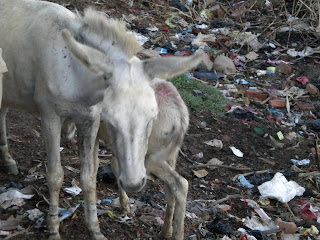Kathmandu, December 10, 2010 – Thousands of Nepalese stray puppies have been sold as ‘Himalayan breeds’ in India in the past decade. This was found when Animal Nepal and Roots and Shoots exposed the illegal trafficking of Nepalese dogs to India by rescuing 42 puppies last night. The puppies were destined for Sonepur Mela, Asia’s largest animal fair, held annually in Bihar. The organisations call for stricter law enforcement and request Nepalese families to come to the rescue by adopting one the puppies.
Animal welfare groups for some time suspected that illegal trafficking of Nepalese puppies to India was going on but were unable to expose the trade. Traders collect stray puppies from the streets of Kathmandu, Lalitpur and Bhaktapur districts and promote them as special Himalayan breeds in India. It is estimated that in the past decade thousands of mixed breed dogs have been sold as pure breeds across the border. Exporting any life animal without official documents is illegal under Nepalese law.
Indian traders Mohammed Sagir, Aka Kallu Miya, Mohammed Ali and Mohammed Nasin, when reporting at the police, said that in the past years they were never asked any questions by Nepalese or Indian authorities. Some of the traders were arrested for bird smuggling in the past but were released as the police deemed the confiscated bird species not important enough for prosecution.
The puppies are cramped in mesh wire cages and transported on top of public buses from Kathmandu to Sonepur in Bihar via Malangala in Siraha. “The puppy trafficking, apart from being illegal, is an extremely cruel business. The majority of puppies are no longer alive when the consignment arrives in Sonepur. They die due to cold, weakness and a lack of food. Most puppies are not properly weaned and don’t stand a chance in the first place,” says Manoj Gautam from Roots and Shoots Nepal.
Last night 37 puppies were rescued from a bus ready to depart from Kalanki bus station while five more were taken from the traders'. They are presently being treated at Animal Nepal’s Chobar Sanctuary. According to Managing Veterinarian Dr Surendra Basyal the condition of the puppies is appalling. “Some of the puppies are not properly weaned. Some are as young as three weeks. When we opened the jute covered cages the puppies were totally wet from sweating. One was squeezed to death while three died overnight. I cannot imagine that any of them would have survived the long journey to Sonepur.”
The puppies will have to be monitored and hand fed for at least four weeks. Animal Nepal says volunteers will be needed to help out with the care.
Volunteer directors Pramada Shah and Lucia de Vries request the public to come to the rescue by adopting a puppy. “The popularity of Nepalese stray puppies in India shows that Nepal’s mixed breeds are as handsome as any pure breed,” they argue.
Roots and Shoots in the past has exposed the growing bird trade in the region, including the trafficking of protected owl species. “The Nepalese dog export in fact funds international bird trafficking. Traders use the stable income from dog sales to buy protected, rare birds and embark on riskier forms of trafficking,” says Manoj Gautam.
Nepal is one of the few countries in the world without an animal welfare law. The breeding and selling of companion animals goes unmonitored and is conducted mostly by unregistered companies.
The Sonepur Mela of Bihar is organized every year in the Hindu month of Kartik (November/December). Indian welfare campaigners have their long voiced concerns about the fair. India’s Environment and Forests Minister Jairam Ramesh recently expressed doubts about the future of the disputed fair.
















